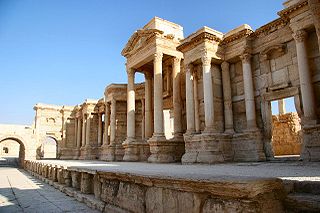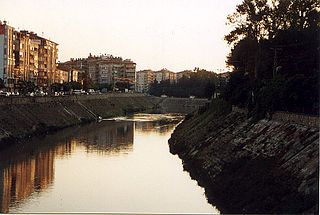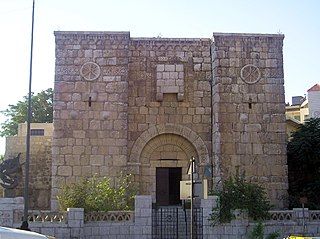The 630s decade ran from January 1, 630, to December 31, 639.

Year 634 (DCXXXIV) was a common year starting on Saturday of the Julian calendar. The denomination 634 for this year has been used since the early medieval period, when the Anno Domini calendar era became the prevalent method in Europe for naming years.

The Battle of the Yarmuk was a major battle between the army of the Byzantine Empire and the Arab Muslim forces of the Rashidun Caliphate. The battle consisted of a series of engagements that lasted for six days in August 636, near the Yarmouk River, along what are now the borders of Syria–Jordan and Syria-Israel, southeast of the Sea of Galilee. The result of the battle was a crushing Muslim victory that ended Roman rule in Syria after about seven centuries. The Battle of the Yarmuk is regarded as one of the most decisive battles in military history, and it marked the first great wave of early Muslim conquests after the death of the Islamic prophet Muhammad, heralding the rapid advance of Islam into the then-Christian/Roman Levant.
ʿĀmir ibn ʿAbd Allāh ibn al-Jarrāḥ, better known as Abū ʿUbayda was a Muslim commander and one of the Companions of the Prophet. He is mostly known for being one of the ten to whom Paradise was promised. He remained commander of a large section of the Rashidun Army during the time of the Rashid Caliph Umar and was on the list of Umar's appointed successors to the Caliphate, but died in the Plague of Amwas in 639 before Umar.

The Battle of Ajnadayn was fought in July or August 634, in a location close to Beit Guvrin in the Roman-era Palestine region ; it was the first major pitched battle between the Byzantine (Roman) Empire and the army of the Arab Rashidun Caliphate. The result of the battle was a decisive Muslim victory. The details of this battle are mostly known through Muslim sources, such as the ninth-century historian al-Waqidi.
The Battle of Hazir or Ma'arakah al-Haadhir took place between the Byzantine army and the Rashidun army's elite cavalry, the Mobile guard. It took place in June 637, three miles east of Qinnasrin at Al-Hadher in present-day Syria.

The Battle of Yamama was fought in December 632 as part of the Ridda Wars against a rebellion within the Rashidun Caliphate in the region of al-Yamama between the forces of Abu Bakr and Musaylima, a self-proclaimed prophet.

The Muslim conquest of the Levant, or Arab conquest of Syria, was a 634–638 CE invasion of Byzantine Syria by the Rashidun Caliphate. A part of the wider Arab-Byzantine Wars, the Levant was brought under Arab Muslim rule and developed into the provincial region of Bilad al-Sham. Clashes between the Arabs and Byzantines on the southern Levantine borders of the Byzantine Empire had occurred during the lifetime of Muhammad, with the Battle of Muʿtah in 629 CE. However, the actual conquest did not begin until 634, two years after Muhammad's death. It was led by the first two Rashidun caliphs who succeeded Muhammad: Abu Bakr and Umar ibn al-Khattab. During this time, Khalid ibn al-Walid was the most important leader of the Rashidun army.
Yazid ibn Abi Sufyan ibn Harb ibn Umayya was a leading Arab Muslim commander in the conquest of Syria from 634 until his death in the plague of Amwas in 639. Following the capture of Damascus around 635, he was placed in command of the city and its military district. After the death of the overall Muslim commander of Syria, Abu Ubayda ibn al-Jarrah, in 639, he was appointed by Caliph Umar the governor of Damascus, Jordan and Palestine.

The siege of Aleppo, the Byzantine stronghold and one of few remaining Byzantine castles in the northern Levant after the decisive Battle of Yarmouk, was laid between August and October 637.

The Battle of the Iron Bridge was fought between the Muslim Rashidun army and the Byzantine army in 637 AD. The battle took its name from a nearby nine-arch stone bridge spanning the Orontes River which had gates trimmed with iron. It was one of the last battles fought between the Byzantines and Rashidun Caliphate in the province of Syria. The aftermath of the battle marked the nearly complete annexation of the province into the Rashidun Caliphate with the fall of its capital, Antioch.

The Rashidun Caliphate was the first caliphate to succeed the Islamic prophet Muhammad. It was ruled by the first four successive caliphs of Muhammad after his death in 632 CE. During its existence, the empire was the most powerful economic, cultural, and military force in West Asia and Northeast Africa.

The Battle of Fahl, also known as the Battle of the Marshes and the Battle of Beisan, was a major battle in the Muslim conquest of Byzantine Syria fought by the Arab troops of the Rashidun Caliphate and Byzantine forces at or near Pella (Fahl) and nearby Scythopolis (Beisan), both in the Jordan Valley, in December 634 or January 635.

The siege of Damascus (634) lasted from 21 August to 19 September 634 before the city fell to the Rashidun Caliphate. Damascus was the first major city of the Eastern Roman Empire to fall in the Muslim conquest of Syria.

The siege of Jerusalem (636–637) was part of the Muslim conquest of the Levant and the result of the military efforts of the Rashidun Caliphate against the Byzantine Empire in the year 636–637/38. It began when the Rashidun army, under the command of Abu Ubayda, besieged Jerusalem beginning in November 636. After six months, the Patriarch Sophronius agreed to surrender, on condition that he submit only to the Caliph. In 637 or 638, Caliph Umar traveled to Jerusalem in person to receive the submission of the city. The Patriarch thus surrendered to him.

The siege of Emesa was laid by the forces of Rashidun Caliphate from December 635 up until March 636. This led to the Islamic conquest of Emesa, which was a major trading city of the Byzantine Empire in the Levant.
Battle of Marj al-Dibaj was fought between the Byzantine army, survivors from the conquest of Damascus, and the Rashidun Caliphate army in September 634. It was a successful raid after three days of armistice, on the Byzantine survivors of the conquest of Damascus.
The siege of Germanicia or Marash was led by Muslim forces of the Rashidun Caliphate during their campaigns in Anatolia in 638. The city surrendered without much bloodshed. This expedition is important because it marks the end of the military career of the legendary Arab Muslim general Khalid ibn Walid, who was dismissed from the army a few months after his return from the expedition.
Abū ʿAbd Allāh Shuraḥbīl ibn Ḥasana was one of the earliest Muslim converts, sahaba and a key commander in the Rashidun army during the Muslim conquest of the Levant.
The Battle of Marj ar-Rum, also known as the Battle of Marj Dimashq, was a conflict between the Rashidun caliphate and the Byzantine Empire. The battle occurred shortly after the Battle of Fahl when the Byzantines attempted to recapture Damascus. Heraclius, the Byzantine emperor, sent two separate forces in the effort, one army led by Theodore the Patricius and a second army led by Shannash al-Rome. The Rashidun army led by Abu Ubaydah ibn al Jarrah and Khalid ibn al-Walid was ordered to assist Yazid ibn Abi Sufyan who was acting as the garrison commander of Damascus.












